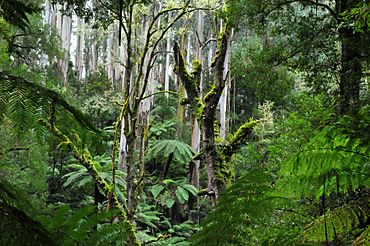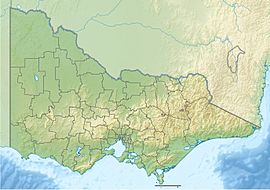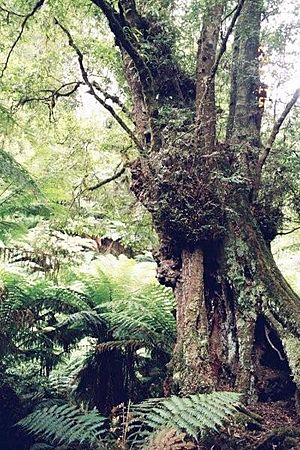Tarra-Bulga National Park facts for kids
Quick facts for kids Tarra-Bulga National ParkVictoria |
|
|---|---|
|
IUCN Category II (National Park)
|
|

Forest near Cyathea Falls, in the national park
|
|
| Nearest town or city | Yarram |
| Established | 17 June 1986 |
| Area | 15.22 km2 (5.9 sq mi) |
| Visitation | 80,000 (in 1995) |
| Managing authorities |
|
| Website | Tarra-Bulga National Park |
| See also | Protected areas of Victoria |
The Tarra-Bulga National Park is a special protected area in Victoria, Australia. It's found in the south Gippsland region, about 240 kilometres (150 mi) east of Melbourne. This park is famous for its amazing forests, especially the tall mountain ash trees and beautiful fern gullies. It's one of the last places where you can see these ancient forests just as they were long ago. The park covers about 1,522 hectares (3,760 acres) and is a very important home for many plants and animals.
Contents
History of Tarra-Bulga National Park
The story of Tarra-Bulga National Park began in 1903. The local council asked the Victorian Government to protect some forest land with fern gullies near a place called Balook.
In 1904, the first part of the park was set aside. It was 20 hectares (49 acres) big and named Bulga National Park. The name bulga comes from the Gunai language and means "mountain."
A few years later, in 1906, another park was created nearby. It was called Tarra Valley National Park. This park was named after Charley Tarra, an Indigenous man from the Burra Burra people. He helped Count Paweł Strzelecki explore this part of Gippsland in 1840.
How the Parks Joined Together
Later, it was suggested that the two parks, Bulga and Tarra Valley, should become one bigger park. This happened in 1986, and the new, larger park was named Tarra-Bulga National Park. It started with 1,230 hectares (3,000 acres) and grew even bigger over the years. By 2005, it covered 2,015 hectares (4,980 acres).
Kara Healey: A Special Park Ranger
One amazing person connected to the park's history is Kara Moana Healey. She was a Maori-Australian woman who worked as a park ranger in the Tarra Valley from 1952 to 1963. She was the first female National Park Ranger in Victoria!
Kara was a great conservationist and naturalist. She collected many plant and animal samples for the National Herbarium of Victoria. She often went into dangerous parts of the valley by herself to find rare plants and even lyrebird nests.
Over ten years, Kara collected more than 160 types of fungi. Two new types of fungi were even named after her! She also collected over 500 animal and insect samples, including 80 types of moss. Thanks to her hard work, Tarra Valley became one of the most studied areas in Australia at that time. Her contributions were celebrated with a special ceremony and plaque in 2007.
Exploring Tarra-Bulga National Park
The park has many fun things to do, especially if you love walking and nature!
There are lots of walking tracks that start from the picnic areas. The Tarra Valley Rainforest Walk is a short and easy path that takes you to Cyathea Falls. Another popular walk is the Fern Gully Nature Walk. On this walk, you can cross Corrigan's Suspension Bridge, which hangs high above the rainforest. It gives you amazing views of the fern gully below!
For those who love longer adventures, there's the Grand Strzelecki Track. This 100-kilometre (62 mi) trail connects Tarra-Bulga National Park with the nearby Morwell National Park. It's a great way to explore more of the beautiful area.
The park is a popular spot for visitors. It has a visitor centre, picnic areas with tables, fireplaces, shelters, and toilets. The visitor centre is open on weekends, school holidays, and public holidays. Volunteers from the Friends of Tarra-Bulga National Park help run the centre and also work to protect the park.
Since 2010, the park has been managed by Parks Victoria together with the Gunaikurnai people. The Gunaikurnai are the traditional owners of this land, and they help look after it.
Plants and Animals of Tarra-Bulga
Tarra-Bulga National Park is a fantastic home for many different plants and animals.
Amazing Plant Life
The deep river valleys in the park are filled with tall mountain ash trees (Eucalyptus regnans). Below these giants, you'll find other trees like blackwood (Acacia melanoxylon) and hazel pomaderris (Pomaderris aspera). The park is also famous for its lush tree ferns, like the soft tree fern (Dicksonia antarctica) and Cyathea australis.
Some parts of the park have cool temperate rainforests, where you can find beautiful Myrtle Beech trees (Nothofagus cunninghamii). On the higher ridges, you'll see different types of eucalyptus trees. The park is also well-known for its many kinds of fungi, which are especially easy to spot in autumn.
Wonderful Wildlife
The rainforest is a safe haven for lots of wildlife. You can find a wide variety of birds here, including the pilotbird, yellow-tailed black cockatoo, eastern whipbird, and currawongs.
When evening comes, other animals start to appear. You might see possums, owls, and bats looking for food. During the day, if you're lucky, you could spot lyrebirds, wombats, swamp wallabies, gliders, and even platypuses in the park's waterways.



